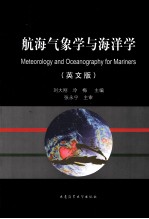

航海气象学与海洋学 英文版PDF电子书下载
- 电子书积分:8 积分如何计算积分?
- 作 者:刘大刚,冷梅主编;张永宁主审
- 出 版 社:大连:大连海事大学出版社
- 出版年份:2011
- ISBN:9787563225477
- 页数:137 页
CHAPTER 1 BASIC KNOWLEDGE OF THE ATMOSPHERE AND METEOROLOGI-CAL ELEMENTS 1
1.1 The Atmosphere 1
1.1.1 Introduction 1
1.1.2 Vertical Structure of the Atmosphere 1
1.1.3 Composition of the Atmosphere 2
1.2 Solar Radiation and Air Temperature 4
1.2.1 Solar Radiation 4
1.2.2 Air Temperature and Temperature Scales 5
1.2.3 Diurnal and Annual Variations of Air Temperature 6
1.3 Atmospheric Pressure 6
1.3.1 Air Pressure and Its Units 6
1.3.2 Variation of Pressure with Height 7
1.3.3 Diurnal and Annual Variations of Air Pressure 8
1.3.4 Isobars 8
1.3.5 Pressure Gradient 8
1.3.6 Common Types of Pressure Fields 9
1.4 Stability of the Atmosphere 10
1.4.1 Concept of Stability 10
1.4.2 Adiabatic Lapse Rate 11
1.4.3 Equilibrium of Stability 11
1.4.4 Stability and Weather 12
1.5 Air Humidity 13
1.5.1 Characteristics of Vapor in the Atmosphere 13
1.5.2 Description of Air Humidity 13
1.5.3 Variations of Absolute Humidity 15
1.5.4 Variations of Relative Humidity 15
1.6 Wind 15
1.6.1 Defiinition and Description of Wind 15
1.6.2 The Beaufort Scale of Wind Force 16
1.6.3 Geostrophic Wind and Gradient Wind 18
1.6.4 Buys Ballot’s Law 20
1.6.5 The Effect of Friction 20
1.7 Clouds and Precipitation 21
1.7.1 The Formation of Clouds 21
1.7.2 The International Classifiication of Clouds 21
1.7.3 Cloud Cover 24
1.7.4 Types of Precipitation 24
1.7.5 Intensity of Precipitation 25
1.8 Visibity and Fog 26
1.8.1 Defiinition and Classifiication of Visibility 26
1.8.2 Defiinition and Classification of Fog 27
1.8.3 Main Types of Fog 28
1.9 Shipborne Observation and Shipborne Meteorological Instruments 29
1.9.1 Shipborne Observations 29
1.9.2 Code Used for the Transmission of Ships Weather Messages 29
1.9.3 Non-Routine Reports 29
1.9.4 Visibility Measurement 30
1.9.5 Wind Measurement 31
1.9.6 Temperature Measurement 31
1.9.7 Air Pressure Measurement 32
1.9.8 Weather Phenomena 33
1.9.9 Cloud Types and Amounts 34
1.9.10 Observing Ocean Waves 35
CHAPTER 2 WEATHER SYSTEMS 36
2.1 Weather Charts 36
2.1.1 Outline of Weather Charts 36
2.1.2 Weather Chart Projections 36
2.1.3 Surface Charts 38
2.2 Air Masses and Fronts 41
2.2.1 Air Mass 41
2.2.2 Front Classification 43
2.2.3 Frontal Elements 44
2.2.4 Weather and Fronts 45
2.3 Extra-tropical Anticyclone 53
2.3.1 Outline of Anticyclone 53
2.3.2 Siberian High 54
2.3.3 Weather Associated with the Extra-tropical Anticyclone 55
2.3.4 Movement of Extra-tropical Anticyclone 55
2.3.5 Cold Air Grades 56
2.4 Subtropical High 56
2.4.1 Formation and Distribution 56
2.4.2 Monitoring of the Northwest Pacifiic Subtropical High 57
2.4.3 Migration of Subtropical High 57
2.4.4 Subtropical High Weather 58
2.5 Extratropical Cyclone 59
2.5.1 Outline Extratropical Cyclone 59
2.5.2 Cyclogenesis 60
2.5.3 Weather Associated with Extratropical Cyclones 61
2.5.4 Cyclone Tracking 62
2.6 Tropical Cyclones 62
2.6.1 Outline of Tropical Cyclone 62
2.6.2 Locations and Seasons 64
2.6.3 Classifiications, Terminology and Naming 66
2.6.4 Chinese Warning System 69
2.6.5 Conditions Necessary for the Formation of TCs 70
2.6.6 Structure and Size 70
2.6.7 Dissipation of Tropical Cyclones 73
2.6.8 Movement and Track 74
2.6.9 Observation and Forecasting 76
2.6.10 Avoiding Tropical Cyclones 78
CHAPTER 3 BASIC KNOWLEDGE OF CLIMATOLOGY 84
3.1 Wind and Pressure Systems 84
3.1.1 Three-cell Circulation Model 84
3.1.2 Major Wind Patterns 86
3.1.3 Observed Wind and Pressure Fields 88
3.1.4 Monsoon 89
3.1.5 Sea and Land Breezes 94
3.2 Areas and Seasons of Strong Winds at Sea 95
3.3 Distribution of Sea Fog 96
3.3.1 General Distribution of Sea Fog 96
3.3.2 Foggy Locations in the Ocean 97
CHAPTER 4 BASIC KNOWLEDGE OF OCEANOGRAPHY 99
4.1 Ocean Currents 99
4.1.1 Outline of Ocean Currents 99
4.1.2 The Formation of Currents 100
4.1.3 Main Ocean Currents 101
4.1.4 El Ni no-Southern Oscillation (ENSO) 103
4.2 Sea Waves 104
4.2.1 Description of Sea Waves 104
4.2.2 Formation of Waves 105
4.2.3 Types of Wind Waves 105
4.2.4 Effects of Currents on Waves 107
4.2.5 Effects of Ice on Waves 107
4.2.6 Tsunamis 107
4.2.7 Storm Tides 109
4.3 Sea Ice 109
4.3.1 Types of Sea Ice 109
4.3.2 Iceberg Drift 110
4.3.3 Extent of Ice in the Sea 111
CHAPTER 5 WEATHER INFORMATION AND SERVICES 113
5.1 Weather Information for Shipping 113
5.1.1 Introduction of WMO 113
5.1.2 Receiving Marine Weather Forecast Products Onboard 114
5.1.3 Radiofax Weather Charts 115
5.2 Interpretation and Application of Weather Charts 116
5.2.1 Interpretation and Application of Surface Charts 116
5.2.2 Interpretation and Application of Wave Charts 121
5.2.3 TC Warning Reports and TC Forecast Charts 124
5.2.4 Interpretation and Application of Satellite Imagery 125
5.2.5 Interpretation and Application of Other Charts 127
5.3 Introduction to Weather Routing 130
5.3.1 Outline of Weather Routing 130
5.3.2 Ship and Cargo Considerations 131
5.3.3 Environmental Factors 132
5.3.4 Synoptic Weather Considerations 134
5.3.5 Types of Recommendations and Advisories 135
5.3.6 Communications 136
Bibliography 137
- 《海洋文明小史》倪谦谦责编;王存苗译;(法)雅克·阿塔利 2020
- 《海洋功能食品》王卉 2019
- 《海洋油气计算流体力学》朱红钧编 2016
- 《上海海洋大学档案里的捕捞学》方舟,汪洁 2020
- 《中国海洋生态红线区划理论与方法》黄伟,陈全震 2019
- 《卫星海洋学》(美)G.A.莫尔著;刘汾汾译 2018
- 《海洋石油生产设施节能措施案例汇编》阎洪涛 2019
- 《海洋生物学专业英语 第2版》王桂忠 2017
- 《2019中国海洋法年刊》唐仲江责任编辑;(中国)中国海洋法学会 2019
- 《2014中国(大连)第三届世界海洋大会论文集 英文》张瑜主编 2014
- 《大学计算机实验指导及习题解答》曹成志,宋长龙 2019
- 《大学生心理健康与人生发展》王琳责任编辑;(中国)肖宇 2019
- 《大学英语四级考试全真试题 标准模拟 四级》汪开虎主编 2012
- 《大学英语教学的跨文化交际视角研究与创新发展》许丽云,刘枫,尚利明著 2020
- 《复旦大学新闻学院教授学术丛书 新闻实务随想录》刘海贵 2019
- 《大学英语综合教程 1》王佃春,骆敏主编 2015
- 《大学物理简明教程 下 第2版》施卫主编 2020
- 《大学化学实验》李爱勤,侯学会主编 2016
- 《中国十大出版家》王震,贺越明著 1991
- 《近代民营出版机构的英语函授教育 以“商务、中华、开明”函授学校为个案 1915年-1946年版》丁伟 2017
